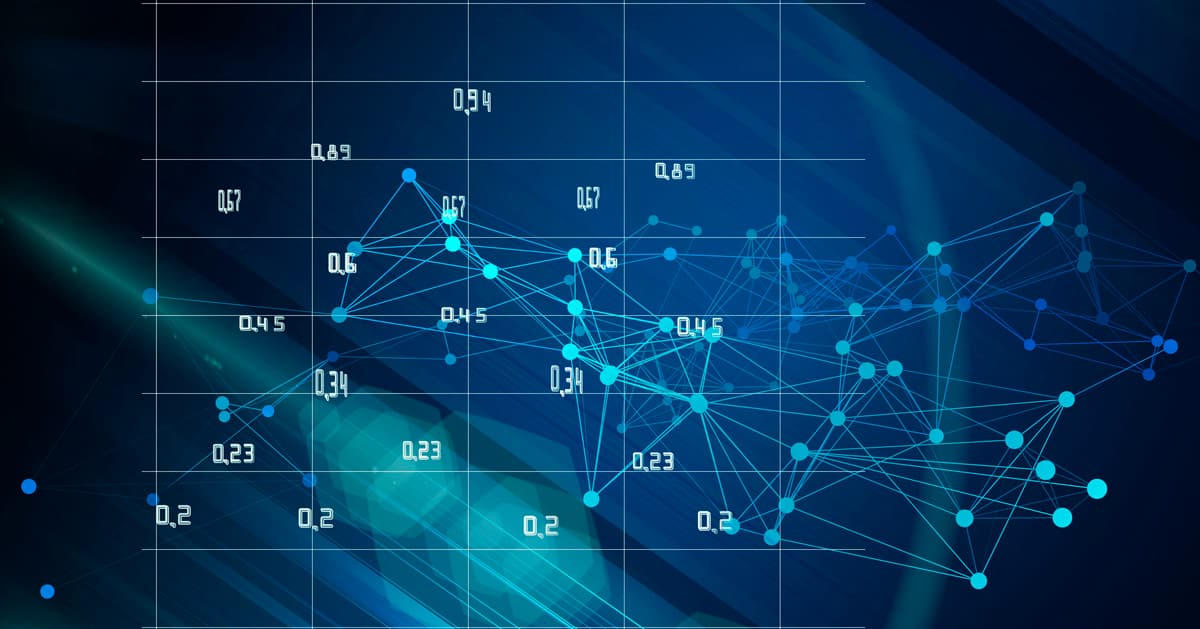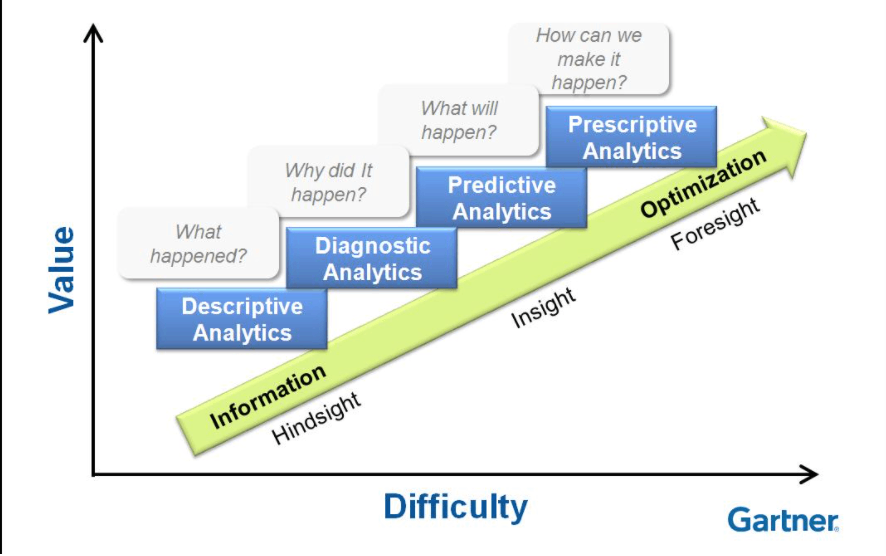
Although often confused, these two approaches serve different yet complementary purposes. Predictive analytics tells you what is likely to happen, while prescriptive analytics helps you decide what to do about it. Together, they provide a powerful foundation for smarter, faster, and more profitable decision-making through advanced data solutions.
The Four Levels of Analytics in Modern Data Solutions
Gartner’s Analytics Ascendency Model highlights four progressive stages of analytics maturity. Each stage answers a different type of question and provides increasing business value:
 Source: Gartner's Analytic Ascendency Model
Source: Gartner's Analytic Ascendency Model
-
Descriptive Analytics – “What happened?”
This is the foundation. Descriptive analytics uses historical data to summarize past performance. Examples include monthly sales reports, customer demographics, and website traffic summaries. While backward-looking, it’s crucial for establishing a baseline of what has already occurred. -
Diagnostic Analytics – “Why did it happen?”
Going deeper, diagnostic analytics identifies the causes behind outcomes. It leverages drill-down analysis, data mining, and correlations to uncover root causes. For example, a diagnostic analysis could reveal that a sales decline was driven by a supply chain delay or a shift in customer preferences. -
Predictive Analytics – “What is likely to happen?”
Predictive analytics uses statistical modeling and machine learning to forecast probabilities and outcomes based on patterns in the data. -
Prescriptive Analytics – “What should we do about it?”
Prescriptive analytics evaluates multiple scenarios and recommends the best course of action to optimize performance.
The more advanced the stage, the more actionable and valuable the insights become. Nisum’s BI and Analytics Continuum white paper dives deeply into how businesses can transition from traditional reporting to advanced data solutions that drive true impact. (nisum.com)
What Is Predictive Analytics?
Predictive analytics uses historical and real-time data to forecast the probability of future events. By applying statistical models and machine learning, it identifies patterns that indicate what could happen next.
Common Business Applications of Predictive Analytics:
-
Customer behavior forecasting – anticipate churn or loyalty patterns
-
Inventory and demand planning – avoid stockouts and overstocking
-
Risk detection – flag fraudulent activity or operational failures
-
Financial forecasting – project revenue growth and market trends
Predictive analytics is invaluable for short-term planning, giving organizations visibility into what’s coming and enabling proactive responses. However, it does not provide guidance on how to act on those forecasts.
What Is Prescriptive Analytics?
Prescriptive analytics goes a step further by recommending specific actions based on predictive insights. It not only forecasts potential scenarios but also analyzes variables, constraints, and business rules to suggest the best path forward.
Common Business Applications of Prescriptive Analytics:
-
Route and supply chain optimization – reduce costs and improve delivery times
-
Pricing strategies – balance customer demand with profit margins
-
Healthcare treatment paths – recommend personalized interventions
-
Maintenance planning – prescribe when and how to service equipment before failures occur
This type of analytics is especially valuable for long-term strategy and optimization, helping leaders choose the most effective course of action within their broader data solutions framework.
Key Differences Between Predictive and Prescriptive Analytics
| Feature | Predictive Analytics | Prescriptive Analytics |
|---|---|---|
| Purpose | Forecast what is likely to happen | Recommend what actions to take |
| Data Inputs | Historical data, patterns, statistical models | Predictive outputs + business rules, constraints, real-time data |
| Complexity | Moderate (statistical models, machine learning) | High (optimization, simulation, AI-based decision models) |
| Output | Probabilities, forecasts, risk scores | Actionable recommendations and optimized scenarios |
| Business Value | Enables proactive planning | Drives strategic decision-making and execution |
Why Businesses Need Both
Relying solely on predictive analytics leaves organizations with insights but no clear guidance. On the other hand, prescriptive analytics depends on predictions to generate meaningful recommendations.
Predictive = “What might happen?”
Prescriptive = “What should we do about it?”
When combined, these methods form a holistic data solution that empowers businesses to forecast, plan, and optimize with confidence.
How Analytics Materializes as Data Solutions
At this point, many leaders ask: “What does analytics actually look like inside a company? Is it a tool, a platform, or something else?”
Analytics is not a single piece of software or hardware — it’s a process and ecosystem. It typically includes:
-
Data sources (ERP, CRM, sensors, e-commerce platforms, etc.)
-
Storage and processing systems (cloud data warehouses, pipelines)
-
Models and algorithms (statistical models, AI/ML frameworks)
-
Visualization and reporting tools (dashboards, BI platforms, alerts)
Nisum’s Data Ingestion Accelerator is one example of how we help clients unify diverse data sources into operational analytics pipelines that power actionable data solutions. (nisum.com)
For end users, analytics usually materializes as dashboards, automated reports, and real-time recommendations that guide decision-making. Behind the scenes, it’s powered by a blend of technology, data governance, and skilled teams.
Keeping Analytics Models Relevant
One critical best practice is to regularly update models with fresh data. Market conditions, consumer behavior, and external factors shift rapidly. Without recalibration, even the most sophisticated predictive or prescriptive models lose accuracy and effectiveness.
Organizations that continuously feed their analytics engines with real-time, high-quality data will gain a sustainable competitive advantage. Nisum’s Cloud & Data Services support scalable infrastructure to fuel continuous data solutions. (nisum.com)
Final Takeaway
Businesses don’t have to choose between descriptive, diagnostic, predictive, or prescriptive analytics — they should leverage all four. Each stage builds on the last, with predictive and prescriptive delivering the most forward-looking value.
-
Descriptive explains what happened
-
Diagnostic explains why it happened
-
Predictive forecasts what’s next
-
Prescriptive recommends what to do
With the right data solutions, organizations can move from reactive decision-making to proactive and optimized performance.
For insights on accelerating analytics transformation, check out Nisum’s partnership with Databricks, designed to bring unified insights through a modern Lakehouse Platform. (nisum.com)
Ready to unlock the full potential of your data with advanced data solutions?
Contact Nisum’s experts to explore how predictive and prescriptive analytics can transform your business strategy.



